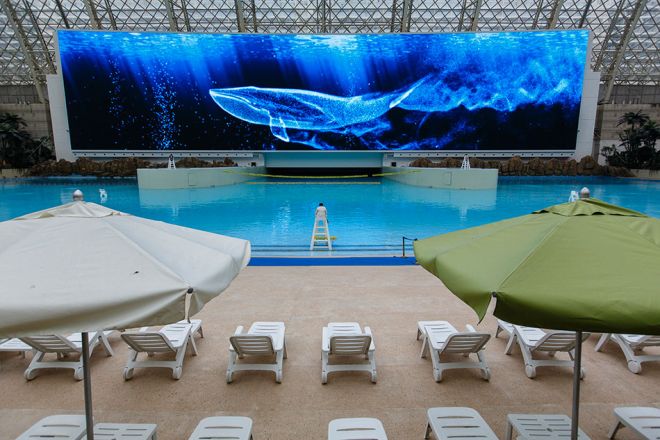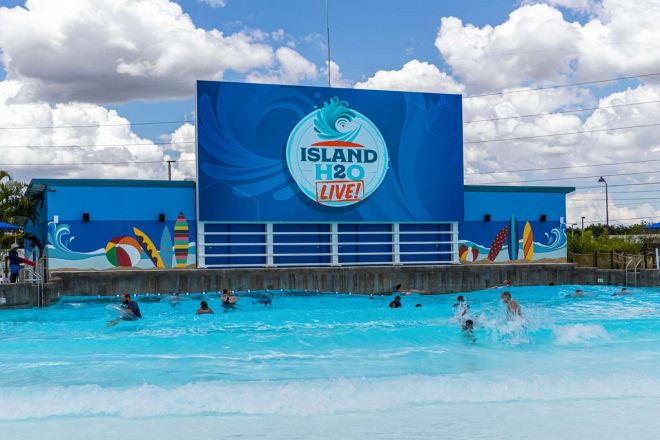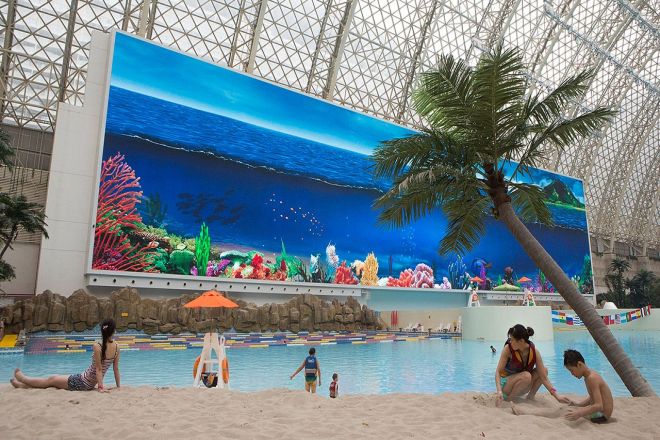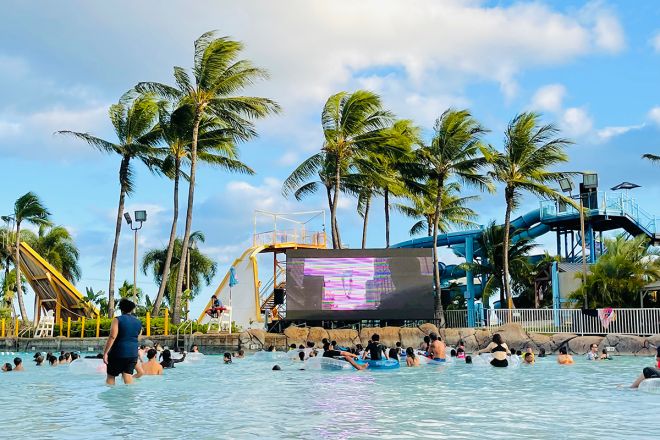Introducción

With the increasing popularity of water parks, how to improve the experience of tourists has become a focus of water park operators. Among them, pantallas LED are an important tool for information display and event promotion, and their application in water parks is becoming more and more extensive.
However, due to the special environment of water parks, such as high humidity and strong sunlight, higher requirements are placed on the performance of LED displays.
1. Waterproof and weather resistance requirements

1). Waterproof performance
- Display housing:
The housing of the display must reach a high waterproof level (such as IP67 or higher) to ensure normal operation in the humid or submerged environment of the water park. The housing design should be tight and seamless to prevent moisture from penetrating.
- Internal circuits and components:
The circuits and components inside the display must be waterproof, including waterproof coating, sealing treatment, waterproof packaging, etc., to prevent moisture intrusion and cause short circuits or damage. At the same time, it is necessary to ensure that all connectors and interfaces have good waterproof performance.
- Ubicación de la instalación:
The installation location of the display should be carefully selected, away from possible water sources, such as pools, water slides, etc. This can reduce the impact of accidental splashing or water flow on the display.
2). Weather resistance
- Resistant to harsh climates:
Since water parks often face harsh climates such as direct sunlight, high temperatures, and high humidity, the display must have excellent weather resistance. This includes being able to resist UV rays, maintain bright colors, maintain clarity, and work properly in high humidity.
- Corrosion-resistant materials:
The material of the display should be corrosion-resistant and able to resist erosion by chemical cleaners or substances such as salt commonly used in water parks. This helps ensure that the display will not be affected by chemical corrosion during long-term use.
- Weather resistance test:
During the manufacturing process, the display should undergo rigorous weather resistance tests to verify its performance and stability in various harsh climates. These tests can simulate environments such as long-term direct sunlight, high temperature, and high humidity to ensure that the display can operate reliably for a long time in actual use.
2. Display effect and brightness requirements
1). Efecto de visualización
- High definition and high contrast:
The LED display screen of the water park should have high definition and high contrast to ensure that visitors can clearly see the display content from a distance and in direct sunlight. High-resolution displays can provide more delicate and realistic images, while high contrast ensures that the display content is still clearly visible under strong light.
- Bright colors and high saturation:
In order to attract the attention of tourists, the display screen needs to present images with bright colors and high saturation. Bright colors can stimulate the interest of tourists and enhance their play experience.
- Support multiple formats:
The display screen should support display content in multiple formats, including pictures, videos, text, etc. This allows the display content to be flexibly adjusted according to different publicity needs, providing tourists with a richer and more diverse information display.
2). Brillo
- Sufficiently high brightness:
The LED display screen of the water park needs to have enough brightness to cope with the high-brightness environment under direct sunlight. The high-brightness display screen can ensure that the display content is still clearly visible under strong light, providing tourists with a better viewing experience.
- Automatic brightness adjustment function:
In order to save energy and adapt to different ambient light, the display screen should have an automatic brightness adjustment function. This function can automatically adjust the brightness of the display screen according to the changes in ambient light, ensuring that it will not be too dazzling when the light is dark, and at the same time maintain sufficient brightness when the light is bright.
- Night mode:
Considering the needs of night use, the display screen should have a night mode. In night mode, the display screen can reduce the brightness to avoid discomfort to tourists. At the same time, the night mode can also adjust the color and brightness of the displayed content as needed to provide a more comfortable viewing experience.
3. Stability and reliability requirements

1). Stability
- Fuente de alimentación:
The display must be equipped with a stable power supply system to ensure that it will not fail due to power fluctuations or interruptions during long-term operation. This includes the use of high-quality power supply equipment, a backup power supply, and an intelligent power management system.
- Cooling system:
An efficient cooling system is the key to ensuring the stable operation of the display. The display should be equipped with suitable cooling equipment, such as fans, radiators, etc., to ensure that the internal components will not overheat in a high-temperature environment, thereby ensuring its performance and life.
- Electromagnetic interference and signal attenuation:
The internal circuit design of the display should be reasonable to avoid electromagnetic interference and signal attenuation. The use of high-quality electrical components, reasonable wiring, and effective shielding measures can ensure the stability and accuracy of signal transmission.
- Remote monitoring and fault diagnosis:
In order to detect and deal with problems in a timely manner, the display should support remote monitoring and fault diagnosis functions. Through remote monitoring, administrators can understand the operating status of the display in real time; through the fault diagnosis function, faults can be quickly located and repaired to reduce downtime.
2). Reliability
- Service life and failure rate:
The display should have a long service life and a low failure rate. By selecting high-quality materials, optimizing the design, and strict manufacturing process, it can be ensured that the display screen can maintain stable performance and reliability in long-term use.
- Diseño modular:
In order to facilitate the maintenance and replacement of faulty modules, the display screen should adopt a modular design. The display screen is divided into multiple independent modules, each of which has independent functions and interfaces so that the modules can be easily replaced and upgraded, and the maintenance efficiency can be improved.
- Lightning protection and anti-static measures:
The environment of the water park may have potential threats such as lightning and static electricity, so the display screen should have corresponding protection measures. By installing lightning protection equipment and using anti-static materials, the safe operation of the display screen in harsh environments can be ensured.
4. Installation and maintenance requirements
1) Instalación
- Viewing angle and distance:
The installation location of the display screen should fully consider the viewing angle and distance of tourists to ensure that most tourists can get the best viewing effect. This requires a detailed analysis of the layout of the water park and the flow path of tourists to determine the best installation location.
- Sturdy bracket or wall:
The display screen should be installed on a sturdy bracket or wall to ensure its stability and safety. Especially in the case of strong wind or water impact, the installation structure must be able to resist the influence of these external forces to prevent the display screen from falling off or being damaged.
- Waterproof and electrical safety:
During the installation process, special attention should be paid to waterproof and electrical safety. The display housing and internal circuit must meet the waterproof requirements to prevent water intrusion and cause equipment damage or safety accidents.
At the same time, all electrical connections and wiring must meet safety standards to avoid electrical safety hazards such as leakage and short circuits.
2) Mantenimiento
- Limpieza y mantenimiento periódicos:
In order to keep the display screen neat and tidy and the display effect good, the display screen should be cleaned and maintained regularly. This includes removing dust, stains, and other debris on the surface of the display screen, checking and repairing damaged pixels or modules, and adjusting parameters such as the brightness and contrast of the display screen.
- System inspection:
Regularly check the power supply, heat dissipation, and other display screen systems to ensure their normal operation.
This includes checking whether the power supply is stable, whether the heat dissipation equipment is working properly, and whether the connection line is loose or damaged. If a problem is found, it should be handled in time to avoid affecting the normal use of the display screen.
- Manejo de fallas:
When the display screen fails, it should be repaired, or the faulty module should be replaced in time. This requires maintenance personnel to have professional skills and knowledge to quickly and accurately diagnose the problem and take appropriate treatment measures.
At the same time, a complete fault handling process should be established to ensure that faults are handled promptly and effectively to avoid affecting the tourists’ experience.
5. Safety requirements

1). Electrical safety
- Compliance with standards:
The display screen must strictly comply with relevant electrical safety standards to ensure the absolute safety of the power supply and equipment operation. This includes the use of standard electrical components, cables, and connectors, as well as the correct installation and wiring methods.
- Protection function:
The display screen should be equipped with protection functions such as overcurrent, overvoltage, and overheating to prevent serious safety accidents such as equipment damage or fire caused by electrical anomalies. These protection functions should be able to automatically detect abnormal conditions and take corresponding measures for protection.
2). Human safety
- Reasonable design:
The corners and protruding parts of the display screen should be reasonably designed to avoid sharp edges or protruding parts to reduce the risk of accidental injury to tourists. In addition, the installation location of the display screen should also take into account the range of activities of tourists to avoid collisions with tourists.
- Parameter control:
The brightness, contrast, and other parameters of the display screen should be controlled within a reasonable range to avoid adverse effects on the eyesight of tourists. Excessive brightness or contrast may cause discomfort or fatigue to tourists, and may even cause long-term damage to their eyesight. Therefore, these parameters should be set reasonably according to the actual environment and needs.
Conclusión
The LED display screen installed in the water park needs to meet many requirements, such as waterproof and weather resistance, display effect and brightness, stability and reliability, installation and maintenance, and safety.
Only by meeting these requirements can we ensure that the LED display screen can operate stably in the water park environment, provide tourists with clear and vivid information display, and enhance the tourists’ play experience.
Finalmente, si quieres saber más sobre las pantallas LED, Por favor póngase en contacto con nosotros.
